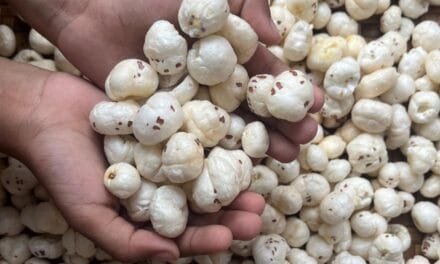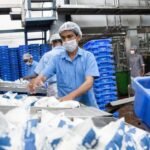In the last two decades, human productivity has in fact gone up thirty times in technology sectors. And processed food industry will not be an exception. Rajat K. Baisya explores how automation and collaborative robots (cobots) are transforming the Indian food processing industry.
The agro-based industry in India holds significant promise to emerge as a global supply source. This we have been talking about for decades. A lot of development is happening in terms of food processing industry in India process and manufacturing technology. India is an agriculture-rich country and about 16% of our GDP is contributed by agriculture.
In spite of having the distinction of the number one producer in the world for many agricultural and horticultural products, as well as low farm labour wages, we are an insignificant player in the international market, contributing only about 2.5% of global trade in thefood and agricultural sector.
The reason is high wastage and low productivity, which makes the Indian processed food products globally non-competitive. The level of processing, as well as value addition, is still very low. Our domestic consumption of processed food is also low because processed foods are costlier, and fresh foods are easily available, which consumers prefer. You can learn more about the current state of food processing and agricultural exports in India.
The Role of MNCs in Processed Food Growth
The majority of the Indian food industry is still in the unorganised sector. However, the growth of the processed food sector in India is largely due to the efforts of large players and multinationals (MNCs).
Multinationals are helping the industry grow by introducing new products, innovation, and upgrading process technology. The investment is also largely coming from MNCs. Some of them are entering the Indian market through the acquisition of Indian family-owned companies.
MNCs are primarily interested in the large domestic market in India. Therefore, acquiring a local company helps them to get an easier entry into the domestic market and learn the tricks of the trade and the value system of Indian business better. You can find out more about India’s leading food companies and global expansion.
Migrant Labour for Farm Sector and Food Industry
Automation, although not a new thing in the farm sector but in India, it is still limited to the use of the tractor, and in large farms, may be using a harvester. But not beyond that. For insights on improving agricultural productivity, refer to this article on technological advancements in food processing here.
A large part of the agricultural farm labour workforce comprises migrant workers from states like UP, Bihar, and Andhra Pradesh. During sowing and harvesting seasons, they move to states like Punjab and Haryana, often living in difficult conditions and facing exploitation by landlords and farm owners.
Over the years, the number of migrant labourers has been declining, which poses a challenge to the farm sector. In our country, farming is still largely traditional and labour-intensive.
Although automation in food industry is not new globally, in India it is still limited to basic equipment like tractors and harvesters. For insights on food technology innovations India, refer to PFI’s case study on how robots in food industry can improve productivity.
Agriculture engages a large workforce
Although agriculture contributes only 16% of our GDP now, it absorbs over 50% of the total workforce. This workforce is employed in the season, but their working conditions are still poor. The farm sector does not follow the minimum wage act, and the farm labourers are not organised. Their wage is low, but their productivity is also low. Because of the low level of technology deployment during harvesting as well as in post-harvest stages, our wastage and cost of the agricultural commodities are higher than desirable.
Robots in Agriculture
Robots in agriculture: Many agricultural products require very quick harvesting, many also require delicate handling, and in those situations, the use of robots in Indian food factories can increase productivity as well as perform delicate and high precision work with accuracy and therefore, reduce cost and help to improve the competitiveness of the agricultural sector.
Robots that are capable of working alongside human beings and animals are called cobots in food processing, or collaborative robots in food packaging. Cobots can be successfully used in the farm sector as well as in the food processing industry in India and the processed food sector in India. Cobots can release skilled workforce to the areas or for tasks that are more suitable to their skillsets. And this can come with a rapid or short payback period, making cobots or robots in food industry operations an ideal choice. Learn more about robots in the food industry.
There are significant advantages to engage cobots to work alongside the human workforce in agriculture and food processing industries in the sense that cobots will be able to deal with a lot of the strenuous, repetitive work involved in things like lifting and moving, and can even work under difficult work conditions like the application of pesticides and weedicides, which is hazardous in agricultural fields. Cobots will not fall sick, requiring sick leave and medical treatment.
Cobots can take a lot of heavy work out of agricultural operations once the crops have been harvested helping both farming and food processing companies to boost product quality and customer responsiveness. Cobots can automate labour-intensive activities and make the operations cost-competitive. Cobots can also be used in agricultural farms collectively on a cooperative basis, meaning cobots can be made available on hire only during the season for a specific cost of service for a period when required. That way, an individual farmer can avoid capital investment.
Robots in Food Industry
During mango season, we have seen a significant rise in the temporary workforce engaged for mango processing to produce mango pulp, which is largely exported and also sold to large processors like Coke, Pepsi, and Parle in the domestic market. Mango season lasts about two months, with the peak period. During that time, mango processing industries work round the clock, and as getting such a large workforce is not easy for those manufacturing units located in remote areas, most of the processors keep workers within the factory premises and make them work overtime, which is at least 12 hours a day. You can take a look at the role of automation in food packaging here.
These workers will need food and shelter, which processors need to provide, and that is a significant cost, complexity, and administrative challenge for the processors. Cobots can easily replace that workforce and help reduce the cost of operation, as well as complexity and management challenges, in addition to providing better hygiene and quality. I can see a distinctive advantage of engaging (Cobots) robots in the food industry, which is somewhat seasonal in nature. Mango pulp is packed in an aseptic bag-in-box for export, which can be totally automated, improving the product hygiene and productivity, which overseas buyers will prefer.
In Action: Robots in food industry and farms
GNE Farm Equipment in the USA is using collaborative robots (cobots) to reduce the labour costs associated with milking cows, thus helping the company to deal with the long-standing problem of acute shortage of qualified milkers. The cobots automate the labour-intensive process of manually disinfecting cows’ udders before and after being milked. The conventional system of tackling these requirements normally involves a large robot equipped with cameras and a spray system. When triggered, the robot sends a six-foot-long pipe with a sprayer under the cow to apply disinfectant. These floor-mounted robots require expensive installation into the floor of the milking parlor as well as fencing to safeguard employees. The installation of robots is expensive and also requires professional programming and training of employees. It also requires costly re-programming if there is a power failure and the robots lose power. Cobots are an ideal replacement in such a situation.
Orkla Foods in Sweden uses cobots in food manufacturing to pack bags of vanilla cream into cartons as part of a network including carton erector, packer, carton sealer, and filling machine. When process requirement is flawless, cobots eliminate costly supervision and extra support, making them more productive. Orkla Foods is present in India, having entered the Indian food industry by acquiring MTR Foods. If they use cobots abroad, the day won’t be far that Orkla will implement automation in food industry operations in India as well.
There are many agricultural products which have a very short season and manufacturers of end product have to stock their entire year’s requirement during the season itself. Amla is another fruit largely available in UP and Bihar and very short season lasting about a month and it is required as an essential ingredient in Chyawanprash manufactured by companies like Dabur and Baidyanath, Himalaya etc. Amla pulp has to be stored in preserved form to be used during the winter season when consumption of Chyawanprash is highest. Cobot is a definite advantage in such operations.
There are many agricultural products with very short seasons, and manufacturers must stock their entire year’s requirement during the season itself. Food processing automation helps address seasonal food processing challenges in India, like amla pulp for Chyawanprash producers (Dabur, Baidyanath, Himalaya). Cobot automation ensures a year‑round supply with better hygiene and lower cost.
I can also see the practical application of cobots in the marine food processing industry in India, which is also highly labour-intensive. Cobots can help profitability improvement in marine food processing and make it globally more competitive. Use of cobots will also reduce the incidence of quality failure, which is quite often in the processed food industry.
In India, Universal Robotics Ltd, a Danish company, is operating having its office in Bangalore and supplying cobots to many industries in other areas, and they control a large part of the global market, making them a leader in cost-effective and affordable manufacturer and supplier of collaborative robots. In India, Project & Technology Management Foundation has a strategic partnership with an EU-funded Competence Centre ROBOFLEX working on the application of Robotics in SME sectors in Europe.
Learn about innovative food technologies transforming the industry here.
Conclusions
The general perception everyone has is that Robots will take away the jobs of human beings, making them unemployed. When the personal computer (PCs) was first introduced in the sixties, there was resistance from the workforce in offices and factories for the fear that manual work would be eliminated, resulting in unemployment. But the fact of the matter is that the computer did eliminate many types of manual work, but people were not thrown out of employment. Explore the potential of automation in food processing here.
New employment opportunities were created, people learned to use the computer for productive purposes. And the internet has actually revolutionised the way we do business today. The technology has improved human productivity several times. In the last two decades human productivity has in fact gone up thirty times in technology sectors. We have now entered industrial revolution 4.0. The fourth industrial revolution is bringing together physical, digital and biological change. Everything will also get integrated into a new eco-system and our own identity will also change. As predicted, the impact of the fourth revolution will lead to polarisation of labour force as low skill and even middle-level jobs will be automated.
A large portion of the jobs in the US is said to be at the risk from automation. Policymakers, economists, as well as politicians, are talking about Universal Basic Income (UBI). The changes are going to be so profound that from the perspective of human history there has never been a time of greater promise or even potential peril. Businesses have to gear up for these inevitable changes.
And the processed food industry will not be an exception. Food processing and agriculture will also undergo a remarkable change that we will witness in the coming years. In this article, we have discussed the implications of Robotics in the Processed food industry and Agriculture and how it can improve productivity in Agriculture. In developed countries, including Europe and the US, the use of robots and cobots is quite common even in SME sectors; we should welcome engaging them in our agriculture and food processing. In other industries in India, cobots are already making the news. Cobots will be shortly seen being used in Indian Agriculture and food processing as well.

What are cobots, and how are they used in agriculture?
Cobots, or collaborative robots, work alongside humans and animals to perform tasks like lifting, moving, and applying pesticides. They are also used in delicate harvesting operations, helping reduce costs and improve productivity.
How can robots help the food processing industry?
Robots can automate labour-intensive tasks, improve hygiene and quality, reduce operational costs, and address seasonal workforce shortages. For example, robots are used in mango pulp production and marine food processing.
What are the advantages of using cobots in agriculture and food processing?
Cobots offer several advantages, such as:
Performing strenuous and repetitive tasks. Improving efficiency and productivity. Reducing labour costs and operational complexities. Enhancing hygiene and quality. Making seasonal operations cost-effective by offering a hire-based model.
Will robots and cobots reduce employment opportunities in agriculture and food processing?
While robots and cobots may replace certain manual tasks, they also create new job opportunities by requiring skilled workers to operate and maintain the technology. They enhance productivity and pave the way for economic growth.
What is the future of robotics in India’s agriculture and food processing sectors?
Robotics is expected to revolutionise India’s agriculture and food processing sectors by increasing efficiency, reducing wastage, and improving global competitiveness. Cobots will play a key role in this transformation.
Have a news or topic to share with industry? Write to us editorial@pfionline.com
















